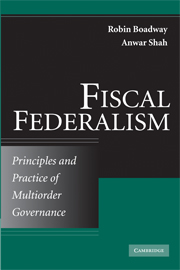Book contents
- Frontmatter
- Contents
- Preface
- PART ONE DESIGNING FISCAL CONSTITUTIONS
- 1 Introduction to Federalism and the Role of Governments in Federal Economies
- 2 The Decentralization of Government Authority
- 3 Expenditure Assignment
- 4 Revenue Assignment
- 5 Natural Resources Ownership and Management in a Federal System
- 6 Local Governance in Theory
- 7 Local Governance in Practice
- PART TWO REVENUE SHARING AND FISCAL TRANSFERS
- PART THREE FINANCE AND PROVISION OF PUBLIC SERVICES
- PART FOUR CHALLENGES AND RESPONSES
- References
- Index
7 - Local Governance in Practice
Published online by Cambridge University Press: 05 June 2012
- Frontmatter
- Contents
- Preface
- PART ONE DESIGNING FISCAL CONSTITUTIONS
- 1 Introduction to Federalism and the Role of Governments in Federal Economies
- 2 The Decentralization of Government Authority
- 3 Expenditure Assignment
- 4 Revenue Assignment
- 5 Natural Resources Ownership and Management in a Federal System
- 6 Local Governance in Theory
- 7 Local Governance in Practice
- PART TWO REVENUE SHARING AND FISCAL TRANSFERS
- PART THREE FINANCE AND PROVISION OF PUBLIC SERVICES
- PART FOUR CHALLENGES AND RESPONSES
- References
- Index
Summary
Local governance historically predates the emergence of nation-states. In ancient history, tribes and clans established systems of local governance in most of the world. They established their own codes of conduct and ways of raising revenues and delivering services to the tribe or clan. Tribal and clan elders developed consensus on the roles and responsibilities of various members. Some tribes and clans with better organization and skills then sought to enlarge their spheres of influence through conquest and cooperation with other tribes. In this way, the first Chinese dynasty, the Xia, was established (2070 to 1600 b.c.) (see Zheng and Wei, 2003). A similar situation prevailed in ancient India, where in the third millennium b.c. (about 2500 b.c.) a rich civilization was established in the Indus Valley (now Pakistan). This advanced civilization placed great emphasis on autonomy in local governance and enshrined a consensus on division of work for various members of the society. This emphasis led to the creation of a class society in which each member had a defined role: upholder of moral values, soldier, farmer, tradesperson, worker. Each community formed its own consensus on community services and how to accomplish them.
Native American tribes in North America and tribes and clans in Western Europe also enjoyed home rule. Subsequent conquests and wars led to the demise of these harmonious systems of self-rule in local governance and to the emergence of rule by central governments all over the world. This development (roughly around 1000 b.c. in Western Europe) ultimately led to the creation of unique systems of local governance and central-local relations in most countries.
- Type
- Chapter
- Information
- Fiscal FederalismPrinciples and Practice of Multiorder Governance, pp. 266 - 290Publisher: Cambridge University PressPrint publication year: 2009
- 1
- Cited by



